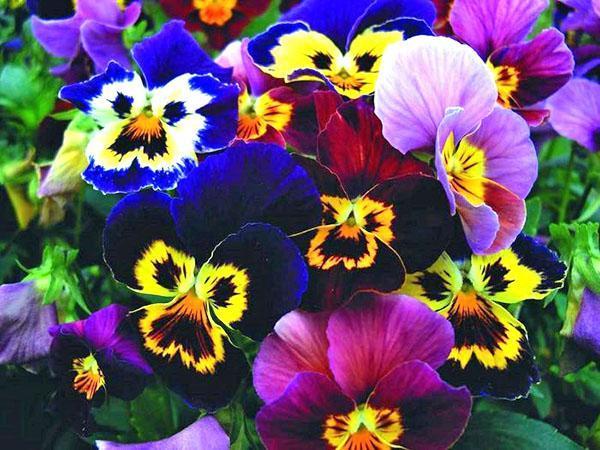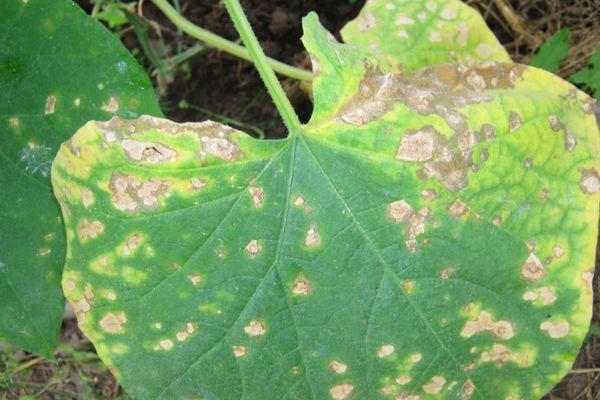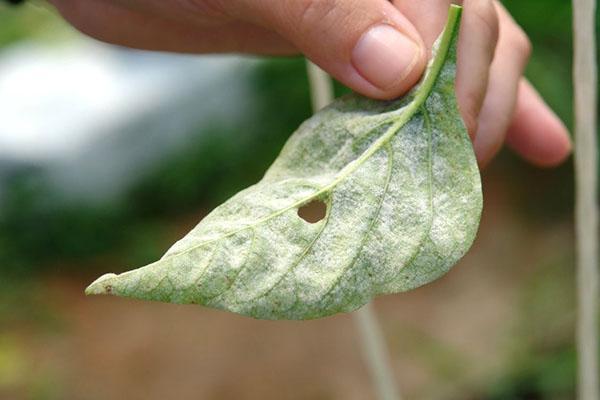Common viola diseases and pests
 Pansies are unique flowers that can decorate any area. But in order to grow beautiful plants, you need to know what diseases and pests of viola are. This flower is liked not only by people, but also by insects. Bushes often get sick, so it is very important to comply with all conditions of care.
Pansies are unique flowers that can decorate any area. But in order to grow beautiful plants, you need to know what diseases and pests of viola are. This flower is liked not only by people, but also by insects. Bushes often get sick, so it is very important to comply with all conditions of care.
Major plant diseases
If you know what your favorite flower is sick with, then there is an opportunity to help it and maintain an amazing flowering.
How to cure viola from ascochitis

It is impossible to use organic feeding for ascochitis, this also applies manure.
Powdery mildew on viola
 This disease manifests itself in the form of a white coating on the surface of the leaf blades. Later, powdery mildew darkens. The infection is very resistant, it does not die on fallen inflorescences, foliage. To prevent pansies from catching this disease, you need to spray the plant with sulfur or preparations Skor, Ordan, Horus. They should be used clearly according to the instructions. All plant remains are destroyed so that the infection does not spread to other beds.
This disease manifests itself in the form of a white coating on the surface of the leaf blades. Later, powdery mildew darkens. The infection is very resistant, it does not die on fallen inflorescences, foliage. To prevent pansies from catching this disease, you need to spray the plant with sulfur or preparations Skor, Ordan, Horus. They should be used clearly according to the instructions. All plant remains are destroyed so that the infection does not spread to other beds.
Reasons for the appearance of gray rot
 High humidity often causes viola to rot. This is due to heavy rains, more often in the second half of the summer period. The plant is covered with a bloom of gray, the stem becomes soft to the touch, "liquidish". If the pansies are sick with gray mold, the plants will have to be destroyed. All neighboring flowers on the site are treated with Maxim or Alirin-B. To prevent gray rot, viola is etched with solutions from Trichoderma, Glyokadin until buds are formed.
High humidity often causes viola to rot. This is due to heavy rains, more often in the second half of the summer period. The plant is covered with a bloom of gray, the stem becomes soft to the touch, "liquidish". If the pansies are sick with gray mold, the plants will have to be destroyed. All neighboring flowers on the site are treated with Maxim or Alirin-B. To prevent gray rot, viola is etched with solutions from Trichoderma, Glyokadin until buds are formed.
Causes of damage to deciduous plates and roots
Clear signs of the onset of most diseases are a change in the color of the foliage and the appearance of spotting on it. If you do not start to treat the plant in time, it will quickly dry up and die.
Phylostictosis of pansies
 The disease is indicated by spots on the leaf blades: brown with a reddish tint, the middle of which is lighter. Then sclerotia are formed, affected pansies dry quickly. To prevent the infection from spreading, it is important to clean the beds from dry plants in the fall.
The disease is indicated by spots on the leaf blades: brown with a reddish tint, the middle of which is lighter. Then sclerotia are formed, affected pansies dry quickly. To prevent the infection from spreading, it is important to clean the beds from dry plants in the fall.
Gall nematode
 The nematoda settles on the roots of the viola. Because of this, galls are formed on the rhizome - growths, swellings about 6 mm in size. In these "balls" the larvae of the parasite develop. When they get out of the ground, they begin to actively gnaw the plant. This problem leads to early wilting of viola in the open field. To remove nematodes, you need to steam the ground before planting the viola. Pests cannot withstand temperatures above 50 degrees. Also, good results are obtained by introducing sodium nitrate. You need to do this about a week before planting the plants in the ground. Consumption is 150 g per square meter.
The nematoda settles on the roots of the viola. Because of this, galls are formed on the rhizome - growths, swellings about 6 mm in size. In these "balls" the larvae of the parasite develop. When they get out of the ground, they begin to actively gnaw the plant. This problem leads to early wilting of viola in the open field. To remove nematodes, you need to steam the ground before planting the viola. Pests cannot withstand temperatures above 50 degrees. Also, good results are obtained by introducing sodium nitrate. You need to do this about a week before planting the plants in the ground. Consumption is 150 g per square meter.
Spider mite
 In dry air, a spider mite settles on the viola. This leads to dehydration of the flower, it weakens.The leaves gradually turn yellow and curl. In this case, you cannot do without insecticides. It is best to process plants with Aktelik, Talstar. You can use Siren or Fufanonn.
In dry air, a spider mite settles on the viola. This leads to dehydration of the flower, it weakens.The leaves gradually turn yellow and curl. In this case, you cannot do without insecticides. It is best to process plants with Aktelik, Talstar. You can use Siren or Fufanonn.
Spider mites are the cause of leaf curling in viola seedlings.
Mother-of-pearl
 The beautiful name of the caterpillar is the larvae of the nymphalid butterflies, but in fact it is a big pest of pansies. They appear in the summer. The caterpillars have a distinctive white stripe on the black back; these are the larvae of an ordinary mother-of-pearl. The caterpillars of the large forest nacre have a different color. It has a huge yellow stripe and brown dashes on the sides. These insects eat both flowers and leaves. As soon as the mother-of-pearl appears on the pansies, an urgent need to apply insecticides. They cope well with the pest Kinmix, Iskra-Bio, as well as Tsitkor.
The beautiful name of the caterpillar is the larvae of the nymphalid butterflies, but in fact it is a big pest of pansies. They appear in the summer. The caterpillars have a distinctive white stripe on the black back; these are the larvae of an ordinary mother-of-pearl. The caterpillars of the large forest nacre have a different color. It has a huge yellow stripe and brown dashes on the sides. These insects eat both flowers and leaves. As soon as the mother-of-pearl appears on the pansies, an urgent need to apply insecticides. They cope well with the pest Kinmix, Iskra-Bio, as well as Tsitkor.
Aphid
 These ubiquitous parasites are very small green insects. They settle primarily on beautiful viola flowers, infect the petals and buds of the plant. Aphids draw out all the juices from the flower, it begins to wither, the petals are greatly deformed. If the aphid colony on the plant is significant, then the culture is covered with drops of white sticky liquid. You can notice them on the leaves and near the peduncles. To get rid of insects, you need to pickle plants with Aktelik or Mospilan.
These ubiquitous parasites are very small green insects. They settle primarily on beautiful viola flowers, infect the petals and buds of the plant. Aphids draw out all the juices from the flower, it begins to wither, the petals are greatly deformed. If the aphid colony on the plant is significant, then the culture is covered with drops of white sticky liquid. You can notice them on the leaves and near the peduncles. To get rid of insects, you need to pickle plants with Aktelik or Mospilan.
The most effective method of dealing with pansy pests and diseases is their prevention. It is better to carry out preventive treatment of plants than to cure them later. But if viola is ill, do not despair: there are many effective drugs on sale. The main thing is not to spare heavily damaged plants and destroy dry foliage and other residues.